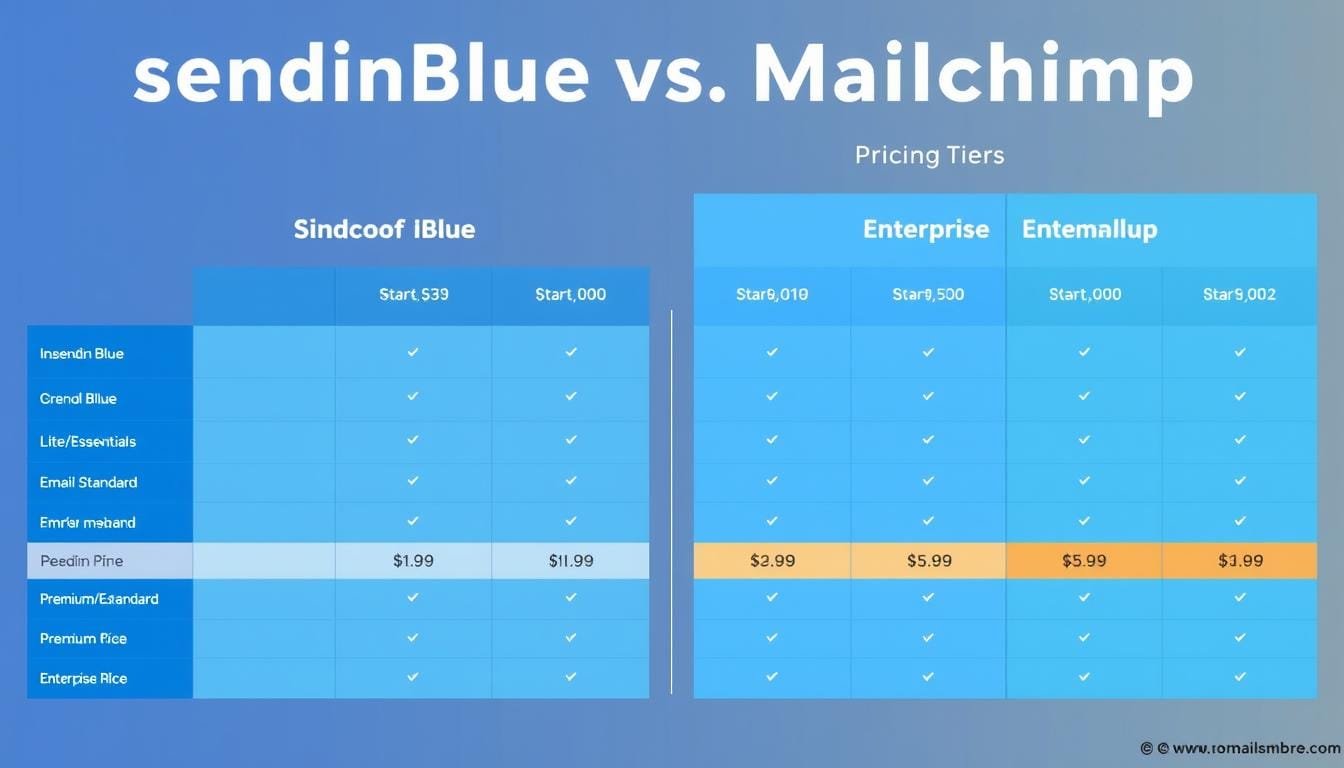SendinBlue vs Mailchimp: Pricing Models Compared
When it comes to affordable email marketing, pricing structure plays a crucial role in your decision-making process. SendinBlue and Mailchimp approach pricing differently, which can significantly impact your costs as your business grows.
SendinBlue vs Mailchimp pricing structure comparison
SendinBlue Pricing Structure
SendinBlue bases its pricing on the number of emails sent rather than the number of contacts in your database. This approach can be particularly advantageous for businesses with large contact lists but moderate email sending needs.
| Plan | Price | Email Limit | Key Features |
| Free | $0 | 300/day (≈9,000/month) | Unlimited contacts, basic email templates, email support |
| Lite | $25/month | Up to 20,000/month | No daily sending limit, A/B testing, email support |
| Premium | $65/month | Up to 20,000/month | Marketing automation, landing pages, Facebook ads, multi-user access |
| Enterprise | Custom pricing | Custom volume | Priority support, custom features, dedicated account manager |
Mailchimp Pricing Structure
Mailchimp’s pricing is primarily based on the number of contacts in your database, with email sending limits tied to each tier. This model can become expensive as your contact list grows, even if you don’t email all contacts regularly.
| Plan | Starting Price | Contact Limit | Email Limit | Key Features |
| Free | $0 | Up to 2,000 | 10,000/month | Basic templates, forms, landing pages |
| Essentials | $11/month | 500 (scales up) | Up to 100,000/month | A/B testing, custom branding, email support |
| Standard | $17/month | 500 (scales up) | Up to 120,000/month | Automation, retargeting ads, custom templates |
| Premium | $299/month | 10,000 (scales up) | Up to 150,000/month | Advanced segmentation, multivariate testing, phone support |
Key Pricing Differences
The fundamental difference between these platforms is that SendinBlue allows unlimited contacts on all plans, while Mailchimp charges based on contact count. This means that as your email list grows, SendinBlue can be significantly more cost-effective if you don’t need to send emails to your entire list frequently.
Another important distinction is that SendinBlue includes transactional emails in their plans, while Mailchimp requires a separate paid add-on (Mandrill) for transactional emails.
Also read: GetResponse Review: Is It the Right Email Automation Tool in 2025?

Mailchimp’s Free Plan limitations
Ready to test drive these platforms?
Both SendinBlue and Mailchimp offer free plans to help you get started without any financial commitment. Try them out to see which interface and pricing structure works best for your business needs.
Key Features Comparison: SendinBlue vs Mailchimp
Both SendinBlue and Mailchimp offer a robust set of email marketing features, but they excel in different areas. Let’s compare their core functionalities to help you determine which platform better aligns with your marketing needs.
Email Design and Templates
The ability to create professional-looking emails without design expertise is crucial for effective email marketing campaigns.

SendinBlue vs Mailchimp: Drag-and-Drop Editor Comparison
SendinBlue Email Editor
- Intuitive drag-and-drop editor
- 65+ pre-designed templates
- HTML editor for custom coding
- Mobile-responsive designs
- Ability to save and reuse custom templates
Mailchimp Email Editor
- Two editor options: classic and new inline editor
- 100+ professionally designed templates
- Built-in photo editing tools
- Content Studio for asset management
- Subject line helper with recommendations
While both platforms offer user-friendly email builders, Mailchimp provides more template options and design tools, making it slightly better for users who prioritize email design flexibility and aesthetics.
Marketing Automation
Automation capabilities allow you to create personalized customer journeys and save time on repetitive marketing tasks.
Also read: Top 10 ChatGPT Alternatives to Try for Smarter AI in 2025

Email Automation Workflow: SendinBlue vs Mailchimp
SendinBlue Automation
- Custom workflow builder with visual interface
- Pre-built automation templates for common scenarios
- SMS integration within automation workflows
- Lead scoring capabilities
- Behavioral targeting based on website activity
- Available on all plans including free
Mailchimp Automation
- Customer journey builder with drag-and-drop interface
- Pre-built customer journeys for different goals
- Behavioral targeting and event-based triggers
- Transactional emails (via paid Mandrill add-on)
- Advanced automation only available on paid plans
- Limited to single-step automation on free plan
SendinBlue offers more comprehensive automation features at lower price points, including on their free plan. Mailchimp restricts advanced automation to their paid plans, making SendinBlue more attractive for automation-focused marketers on a budget.
Landing Pages and Forms
Effective lead generation requires well-designed landing pages and signup forms to capture new contacts.
SendinBlue Landing Pages
- Drag-and-drop landing page builder
- Limited to 5 landing pages
- Only available on Premium plan and above
- Basic form builder with multi-list subscription
- No popup form capability
Mailchimp Landing Pages
- Unlimited landing pages on all plans (including free)
- 10+ landing page templates for different goals
- Integrated with Facebook and Instagram ads
- Both embedded and popup form options
- A/B testing for landing pages (paid plans)
Mailchimp clearly outperforms SendinBlue in the landing page department, offering unlimited pages even on their free plan, while SendinBlue limits this feature to higher-tier plans.
Analytics and Reporting
Comprehensive analytics help you understand campaign performance and optimize your email marketing strategy.
Also read: Voice Search SEO 2025: Rank on Google & Alexa Easily

Deliverability Rates 2023: SendinBlue vs Mailchimp
SendinBlue Analytics
- Real-time campaign tracking
- Open and click rates by domain and time
- Geolocation and device statistics
- Heat map for click tracking
- Limited ecommerce tracking
Mailchimp Analytics
- Comprehensive performance metrics
- Audience growth and engagement tracking
- Comparative reporting against industry benchmarks
- Revenue and ROI reporting
- Click maps and engagement analysis
- Predicted demographics (paid plans)
Mailchimp offers more advanced analytics and reporting features, particularly for ecommerce businesses. Their industry benchmark comparisons and predicted demographics provide valuable insights that SendinBlue doesn’t match.
Looking for specific features?
Both platforms offer unique capabilities that might be perfect for your specific marketing needs. Sign up for free trials to test the features that matter most to your business.
Ease of Use: User Experience Comparison
The learning curve and user interface of an email marketing platform can significantly impact your team’s productivity and satisfaction. Let’s examine how SendinBlue and Mailchimp compare in terms of usability.

Customer Support Response Times: SendinBlue vs Mailchimp
User Interface and Navigation
SendinBlue Interface
- Clean, straightforward dashboard
- Logical menu organization
- Simplified workflow creation
- Quick access to key features
- Mobile-responsive dashboard
Mailchimp Interface
- Modern, visually appealing design
- Intuitive navigation with helpful tooltips
- Personalized dashboard recommendations
- In-app guidance and tutorials
- Mobile app for on-the-go management
Learning Curve
SendinBlue offers a more straightforward experience with fewer options, making it easier for beginners to get started quickly. However, this simplicity sometimes comes at the cost of advanced functionality.
Mailchimp provides more features and options, which can create a steeper learning curve for new users. However, their extensive in-app guidance, tooltips, and educational resources help mitigate this complexity.
Customer Support
Support availability can be crucial when you encounter issues or need guidance with your email marketing campaigns.
| Support Channel | SendinBlue | Mailchimp |
| Email Support | Available on all plans (including free) | First 30 days only on free plan, all paid plans |
| Live Chat | Premium plan and above | Essentials plan and above |
| Phone Support | Premium plan ($65/month) and above | Premium plan ($299/month) only |
| Knowledge Base | Comprehensive | Extensive with tutorials and videos |
SendinBlue offers better support options at lower price points, particularly email support on their free plan and phone support on their $65/month Premium plan. Mailchimp restricts phone support to their $299/month Premium plan, making SendinBlue more accessible for users who value direct support.
Pros and Cons: SendinBlue vs Mailchimp
Let’s summarize the strengths and weaknesses of each platform to help you make a more informed decision.

Pros and Cons of SendinBlue
SendinBlue Pros
- Unlimited contacts on all plans, including free
- More affordable for businesses with large contact lists
- Includes transactional emails at no extra cost
- SMS marketing integration within the platform
- Marketing automation available on free plan
- Better customer support at lower price points
- Full-featured CRM with contact assignment capabilities
- Advanced segmentation with both AND/OR conditions
SendinBlue Cons
- Fewer email templates with less attractive designs
- Limited to 5 landing pages on Premium plan
- No popup form capability
- Fewer third-party integrations (around 50)
- Less robust analytics and reporting
- No social media posting or scheduling
- Limited A/B testing capabilities
- No mobile app for on-the-go management

Pros and Cons of Mailchimp
Mailchimp Pros
- Modern, intuitive user interface
- Extensive library of attractive email templates
- Unlimited landing pages on all plans (including free)
- Both embedded and popup form options
- Advanced analytics with industry benchmarks
- Built-in social media posting and ad management
- More third-party integrations (200+)
- Comprehensive A/B testing capabilities
Mailchimp Cons
- Becomes expensive as contact list grows
- Charges for each contact in multiple lists/segments
- Advanced automation limited to paid plans
- Transactional emails require paid Mandrill add-on
- Limited customer support on free and lower-tier plans
- No SMS marketing capabilities
- Basic CRM functionality without contact assignment
- Segmentation limited to AND conditions (no OR)
Weigh the pros and cons for your business
Every business has unique email marketing needs. Consider which platform’s strengths align with your priorities and which weaknesses you can work around.
Final Recommendation: Which Platform Is Right For You?
After comparing SendinBlue and Mailchimp across multiple dimensions, it’s clear that each platform excels in different areas. Your ideal choice depends on your specific business needs, budget constraints, and marketing priorities.

Ideal User Profile: Who Should Choose Which Platform?
Choose SendinBlue if:
- You have a large contact list but send emails selectively
- You’re on a tight budget and need the most affordable option
- You need SMS marketing capabilities integrated with email
- You want marketing automation features on a free or low-cost plan
- You need transactional emails without paying for an add-on
- You value better customer support at lower price points
- You need a more robust CRM with contact assignment features
Choose Mailchimp if:
- You prioritize design and want access to more attractive templates
- You need unlimited landing pages on a free plan
- You want comprehensive analytics and reporting capabilities
- You need social media integration and ad management
- You value a more intuitive user interface with better guidance
- You need extensive third-party integrations
- You want advanced A/B testing capabilities

Key Takeaways: SendinBlue vs Mailchimp Comparison
For most small businesses with growing contact lists and budget constraints, SendinBlue offers the better value proposition due to its unlimited contacts policy and more affordable pricing structure. However, if you prioritize design flexibility, analytics, and integration capabilities, Mailchimp might be worth the higher cost.
Ready to make your choice?
The best way to determine which platform is right for your business is to try them both. Take advantage of their free plans to test their interfaces, features, and workflows before committing to a paid subscription.
Frequently Asked Questions
Is SendinBlue cheaper than Mailchimp?
Yes, SendinBlue is generally more affordable than Mailchimp, especially for businesses with large contact lists. SendinBlue charges based on email volume while allowing unlimited contacts, whereas Mailchimp charges based on the number of contacts in your database. For example, a business with 10,000 contacts would pay approximately /month with SendinBlue’s Premium plan but could pay 0+ with Mailchimp’s comparable Standard plan.
Which platform has better email automation?
SendinBlue offers more comprehensive automation features at lower price points, including on their free plan. Their custom workflow builder, lead scoring, and SMS integration within automation workflows give them an edge for automation-focused marketers. Mailchimp restricts advanced automation to their paid plans, though their customer journey builder is intuitive and powerful when available.
Can I use both platforms for free?
Yes, both SendinBlue and Mailchimp offer free plans with no expiration date. SendinBlue’s free plan allows unlimited contacts with a sending limit of 300 emails per day (approximately 9,000 per month). Mailchimp’s free plan allows up to 2,000 contacts with a monthly sending limit of 10,000 emails. Both free plans include basic email marketing features, though with limitations on advanced functionality.
Which platform has better deliverability rates?
According to recent deliverability tests, Mailchimp has a slight edge with approximately 68% of emails reaching the primary inbox compared to SendinBlue’s 66%. Mailchimp also has marginally better spam folder rates (30% vs. 31%) and undelivered rates (2% vs. 3%). However, these differences are minimal, and both platforms maintain industry-standard deliverability rates.
Does SendinBlue or Mailchimp offer better customer support?
SendinBlue offers better customer support at lower price points. They provide email support on all plans (including free) and phone support on their /month Premium plan. Mailchimp limits email support to the first 30 days on their free plan and restricts phone support to their 9/month Premium plan. Both platforms offer comprehensive knowledge bases and tutorials.
Can I send SMS messages with both platforms?
SendinBlue offers native SMS marketing capabilities integrated with their email platform, allowing you to include SMS messages in your automation workflows. Mailchimp does not offer built-in SMS marketing, though they do integrate with third-party SMS services like SimpleTexting. If SMS marketing is important to your strategy, SendinBlue has a clear advantage.

SendinBlue vs Mailchimp: Value Proposition by Business Size
Still have questions?
The best way to answer your specific questions is to try both platforms yourself. Their free plans offer a risk-free way to explore their features and determine which one better meets your email marketing needs.
Conclusion: Making Your Final Decision
Choosing between SendinBlue and Mailchimp ultimately comes down to your specific business needs, budget constraints, and marketing priorities. Both platforms offer robust email marketing capabilities with distinct advantages in different areas.
SendinBlue stands out for its cost-effectiveness, particularly for businesses with large contact lists, thanks to its unlimited contacts policy across all plans. It also offers better value in terms of marketing automation, SMS integration, and customer support at lower price points.
Mailchimp excels in design flexibility, analytics, landing page capabilities, and third-party integrations. Its intuitive interface and extensive template library make it particularly appealing for users who prioritize aesthetics and ease of use.
We recommend taking advantage of both platforms’ free plans to test their interfaces, features, and workflows before making your final decision. This hands-on experience will provide the most accurate assessment of which platform better aligns with your specific email marketing needs.

SendinBlue vs Mailchimp: Final Ratings Comparison
Ready to elevate your email marketing?
Don’t let indecision hold back your marketing efforts. Both platforms offer free plans that let you start implementing effective email campaigns today. Choose the platform that best aligns with your priorities and begin connecting with your audience.











